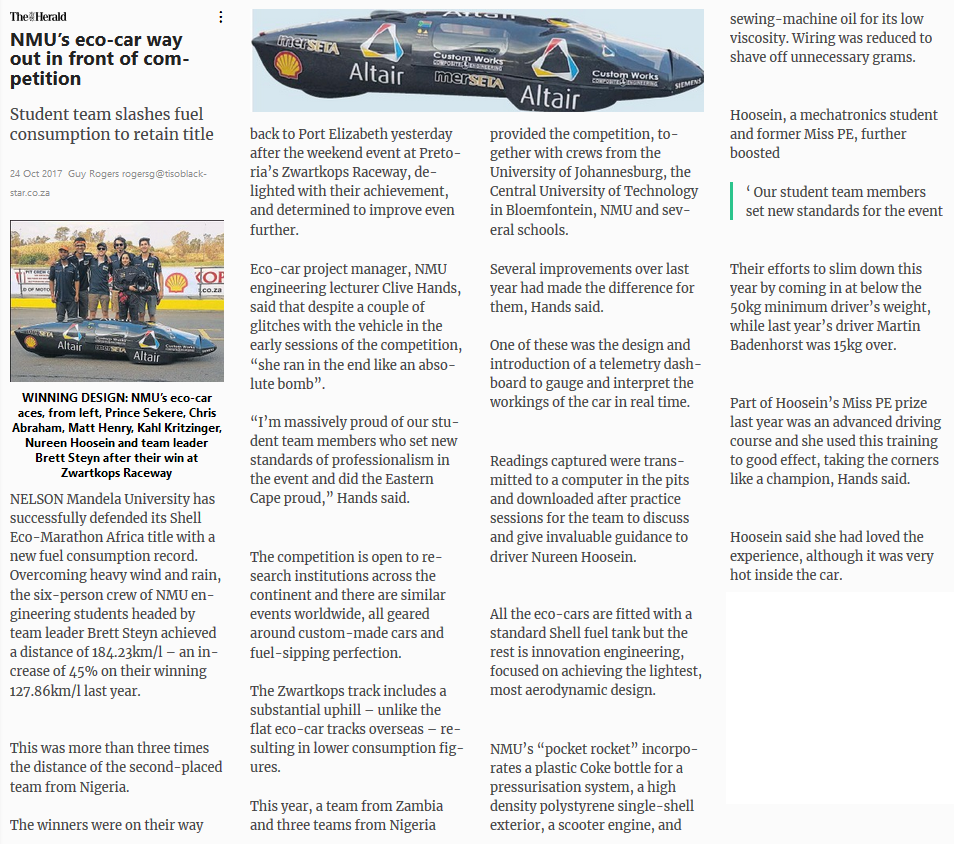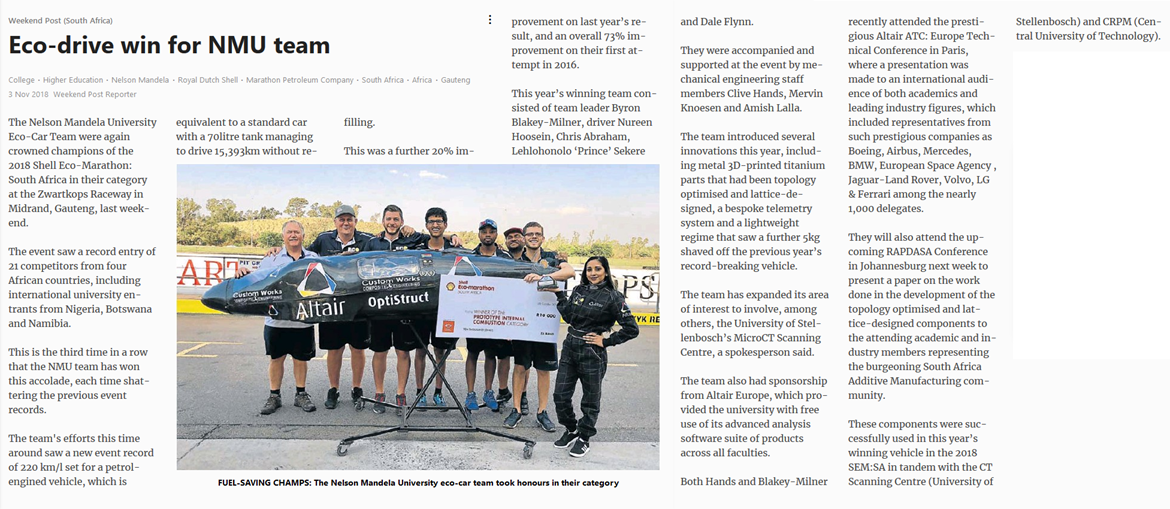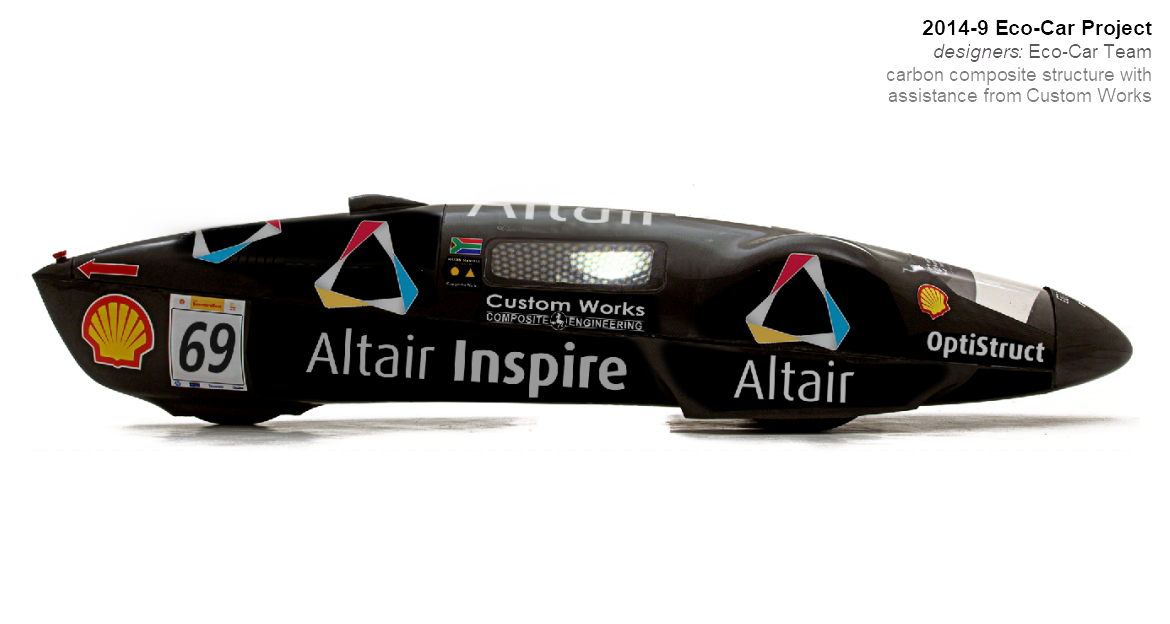
The Eco-Car Project was an exciting project initiated in 2014 and has been in existence until today, where the vehicle serves as a rolling test bench for associated projects in the areas of lightweighting, additive manufacturing, telemetry & electronics for various student Honours and Research projects as well as collaborative projects with our private sector and academic partners.
Below is a fairly expansive story of the project from its early years which saw the team become three-time Champions (2016, 2017, 2018) as well as multiple event record breakers....
Many photos of the Eco-Car project starting right from the beginning of the project are available on the Group's FaceBook album pages - AEDG Photo Albums
Project Initiation
The Eco-Car project was initiated back in early 2014 when Shell’s Norman Koch visited the NMMU and introduced the concept of the Shell Eco-Marathon to the AMTC’s Karl du Preez. This was then introduced to the Solar Car team, who decided to give it a bash. With the demise of the Solar Car project due to escalating costs, the Eco-Car project became the priority project for the team.
With the initial idea of a SEM in Qatar falling by the wayside, the initial aim of the team was to try and make the 2015 SEM: Asia.
The team at this stage fell under the guidance of Faculty member Clive Hands, a lecturer in Mechanical Engineering and Project Manager of previous Baja Bug and Solar Car projects, and Team leader was former Solar Car leader, Jason Humm.
The rest of the team at this stage were Martin Badenhorst, Burger Coetzee, Chris van der Merwe, Oseluole Enabor (all Mech Eng), and Takudzwanashe Vudjizena (Elec Eng).

Early Days
Conceptually, the initial designs were informed by the original PACCar, a Swiss team that were early pace-setters in the SEM: Europe many years back and whose book about their adventures was a great source of information and inspiration. But, as per the Solar Car, reality slowly set in and initial concept designs were subsequently considerably revised to the present form the car has today.
Initial design constraints were to make a full carbon vehicle, as lightweight as possible, but, because of the large automotive representation in the region, to stick to an internal combustion engine option as our initial versions.
In March 2014, initial driver mock-ups were made to get an idea of the design space necessary, followed shortly thereafter in April by a shape mockup using hardboard profiles – this was still in the original PACCar shape – and were mainly used to get a visual on the boundaries to which the design was going to be restricted.
Our next task in April 2014, was to create an Eco-Car mule – an actual running mock-up on which we could try out various configurations of components and systems whilst the overall design was in progress to see what worked and what didn’t. This allowed simultaneous development and testing to ensure what we were getting on a computational platform was bourne out in reality. This served us hugely well with the Solar Car project, and ”Gustav” our solar car mule proved to be invaluable when transferring solid models ideas into actual real-world parts!

This was quite simply achieved using aluminium extrusions that we had lying around, which allowed for great flexibility in changing configurations. The initial mule had no brakes, no safety features at all – the seatbelts were just for show, just an extruded chassis with correct steering configurations and a heavy scooter/CVT option bolted on…a definite hazard, but great fun even though we had to test mainly late in the evenings to avoid the Health & Safety Police!
This didn’t prevent Hummer from trying to turn her over as often as he could, and a memorable incident involved him flat-handing the ground on one occasion to stop it from tipping over as he launched into a high-speed flick of the steering wheel!
The next few months were taken up by long hours of design of the vehicle by all in their various areas of responsibility – resulting in multiple discussions, meetings and revisions as initial ideas were discarded and replaced by newer ones, those ones being replaced by others, etc…; ultimately, sometime in the third quarter of the year, she started to take her final shape, agreed upon by all as the direction forward. Our baby had evolved into something completely different - svelte, beautiful and, yes, definitely sexy!
The governing factor of all internals was the body shape, and the most time was spent on this, squeezing her down into her final aerodynamic form until we were ready, in early November, to commit to the cutting of the monocoque form.
A different strategy of the normal plug-mould-layup used on the Solar Car was decided upon after many discussions of our options – we were to cut the monocoque form from a solid block of high-density polystyrene using Custom Works’ robot CNC and lay-up directly onto the form.
We packed up, and headed down to JBay to supervise the cut, under the watchful, precise and unforgiving eye of Arno Seyfert, our local composites-meister. A long and messy process went just perfectly and several visits later, the top half of the team’s vision had been achieved, prepped and was ready for the tricky process of flipping over to cut the bottom half.

This was a time of some nerves, as even the slightest misjudgement would see the scrapping of this attempt and starting all over again. Fortunately, Arno’s expertise, experience and guidance saw the process quite easily achieved, and the robot was hard at work once more. Meanwhile, we returned to PE and waited nervously for the first photos to come through of the machine’s toil.
She came out just beautifully – a few minor little issues that were easily fixable with a tiny bit of patching; we were thrilled! The guys returned to JBay for final prep and then lay-up – the carbon fun was about to begin…
The Monocoque
The whole of November was taken up with continuing design work & the lay-up of the monocoque, ensuring that we got things just right. Fortunately, we had Arno guiding us every step of the way to ensure that no major mess ups were made, and, after several trips down to JBay, we had her complete – she looked fantastic!
Early December saw the monocoque being returned to our labs at NMMU and the fitting of various parts that, to this point, had only been operational on the mule. By the time we came to close-up for the Xmas/New Year period, we had a functional rolling chassis and our baby took her first tentative steps on the 18th December 2014.
Champagne all round as the team took a well-deserved 3 week break before returning in early January…a sad downside was the loss of Burger as he returned home to Cape Town to further his studies, and Chris, who took up a position in industry.
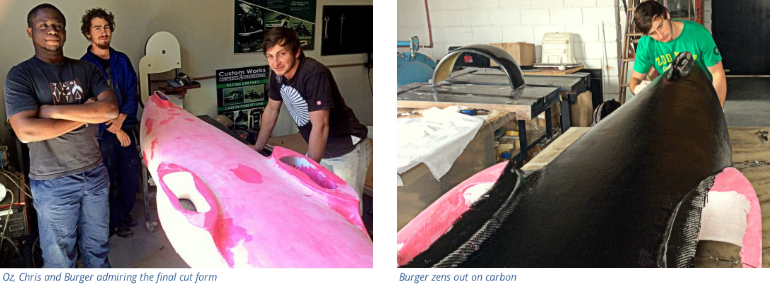
Returning in the second week of January, our plans of trying to make the 2015 SEM: Asia took a blow with funding simply not forthcoming for the huge cost of the logistics and we had to make the decision to pull it…but this turned out to be a godsend as it took a massive weight off the team’s shoulders and gave them considerably more time to work on the designs and get things right first time.
Another sad farewell was made to long-serving team leader Jason, as he decided to get on with his life (!) with a great job opportunity, and Martin stepped forward to capably take over as team leader for 2015. Also joining the team at this stage was Crispin Mukalay, an Elec Eng student, and Mvume Ndimbe, a much-needed Logistics student.
The Body Shell
The next major task facing the team was the upper body shell – Hummer had spent most of the second half of last year sweating blood on this, and the final 3D form had been passed on to Custom Works for cutting back in December. Lay-up had occurred in several sessions in February, and we had the final raw shell through to us at the start of March. Some hard work with sanding and painting saw a more-than-passable blank ready for mold preparation.
Other than the ugly nose (we had to truncate it for the cutting), it was looking damn fine! A new, separate nose cone was designed and drawn up, and pretty soon this was cut and ready for lay-up too. The virtual was turning real very quickly.

By the end of March, after some seriously hard & detailed work from the team, the mold for the upper body-shell was done and dusted, and preparations could be made for the bodyshell lay-up.
We had a bit of a time-crush with the upcoming Knysna Motor Show, so the team were under the cosh in respect of getting things done – many late nights and shredded nerves saw the first body shell produced.
We wouldn’t have the entire shell ready for the show, but at least would have the general shape ready for display, and a lot of the internals were already assembled into the monocoque.

It was off to Knysna for the weekend for a very enjoyable and well-attended Knysna Motor Show, where the developing Eco-Car and the team enjoyed a huge amount of interest from car enthusiasts and the public alike.
Back to reality & more hard work at the eLab saw an adjusted timetable to get everything done in time for the
2015 Shell Eco-Marathon: Africa to be held in a few months at the Zwartkops Raceway in Pretoria.
First thing on the agenda was the new nose, and the integration of this and the upper bodyshell onto the monocoque, as well as the insertion of the windscreen, a nervy process which required significant preparation and care to avoid completely trashing the body-shell.

This was all achieved by the end of June, and the Eco-car was now visibly starting to take shape. By this stage, we had also welcomed another team member in Tinashe Maphosha, another Elec Eng student to bolster that aspect of the team.
Within a short space of time, we had the bodyshell sorted, windscreens and side windows installed, and had the car logo’d up to represent our various sponsors at this stage.
This was July and we were now in full preparation for the Eco-Car Marathon in October. Tribute has to be made to the team at this stage, as all of them were doing this on a part-time basis, juggling their subjects with the extreme demands of a project of this nature – a large portion of which exists beyond just the design and manufacture aspect of the project; a huge demand was being made on their time iro PR and displays and expos (see the Outreach button above). So being able to keep all these balls in the air at the same time required some very special people indeed, and we definitely had them!

Projects such as these are never really carried out to perfection, with very many small unanticipated items taking up far more time than you can ever predict, and it was August before we were able to seriously put her down on the road and do some representative running – time was running out, but so be it!
Our first serious runs were out on the backroads on the South Campus near the stadium and the res’s…and it created quite an interest among some motorists and students, who were double-taking in earnest.

Everything went pretty good all told – a few minor issues picked up, but nothing critical at all, which was testament to the excellent work the guys had put in over the last months.
There was just time to squeeze in a test-day out at the Algoa Go-Kart track before we had to head off inland for the 2015 Shell Eco-Marathon: Africa - things went pretty well, although a couple of issues typically reared their heads for the first time, but we were fairly confident we could sort them out.
September was just a crazy month of finalizing all logistics for the SEM event, and, before we knew it, we were out on the road to Pretoria with still much on the To-Do list to cover!


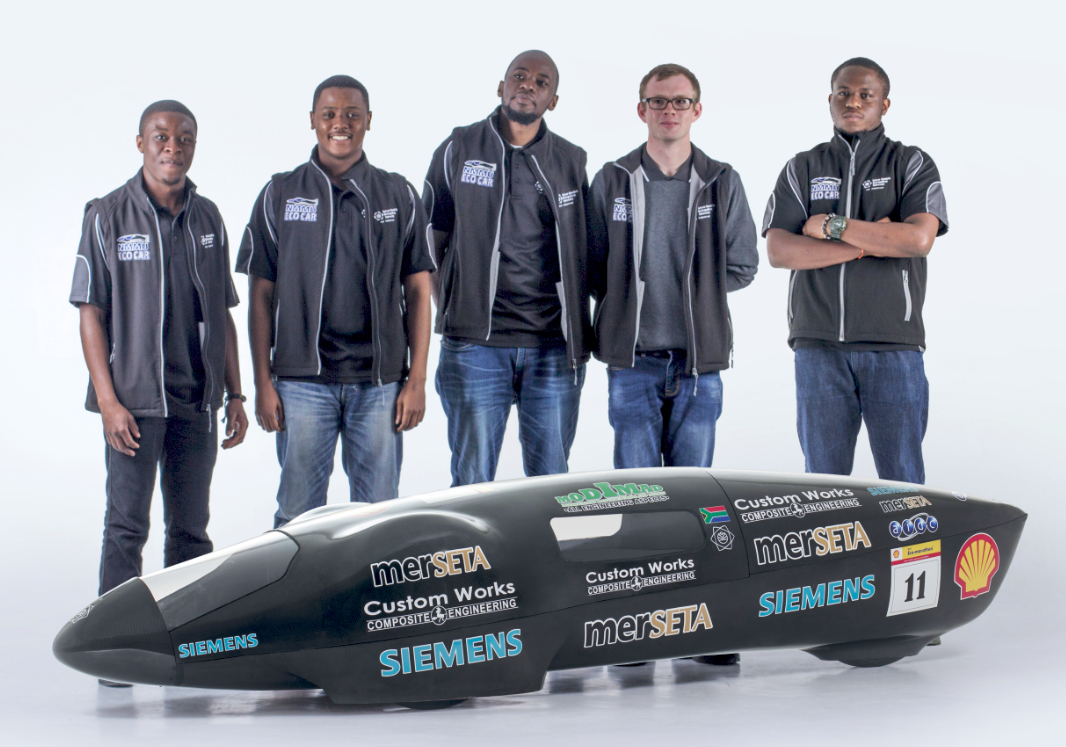
2015 Shell Eco-Marathon: South Africa was a wonderful event, and, on arrival, we could already see that it was going to be well-organised & hugely enjoyable; the UJ organisers were super friendly and accommodating, as were the Shell guys, and Zwartkops was a perfect venue.
Friday night saw an opening dinner where all teams could meet and some basic competition rules were addressed to all teams. After a hard day’s driving the day before, this was just the ticket, and we didn’t need any encourage-ment to tackle a slap-up meal! Scrutineering & practice was scheduled for the next day, so things were going to get real, fast…
Every team feared Scrutineering, especially your first one ever, as the notion of being repeatedly sent back to make this change and that would put the team under huge pressure, particularly so far from home with limited available resources. But, everything went just perfectly and we were, according to the organisers, the first team to ever make it through first time without any issues at all.
In fact, as things were to shortly prove, things were going rather too well!

We lined up first on the pit exit for practice, and the first indication that things were going to head south started appearing – the car was a little reluctant to bite off the line. This was something new, as it hadn’t shown in the test runs - we had a major clutch problem, and it chose the worst possible time to show itself.
The first run wasn’t bad; in fact our baby looked magnificent as she headed down the back straight and then up past the pits for the first time, but, with each restart, the problem got significantly worse, and we were 1200 kms from home!
The only solution was to open it up and see what was causing the problem - the clutch was down to bare metal and, as luck would have it, the spare we intended to have was held up by a payment snafu in the weeks leading up to the event. We were dead in the water before the real event had even begun! What a nightmare!
Frantically phoning around didn’t really help as, to compound things, today was the rugby test match between South Africa and Australia in Pretoria, and all the obvious places to buy a replacement were closing and heading off for the game and, as a result, weren’t too interested in the urgency of our problem! It seemed like the gods were playing a horrible trick on us…
It took a phonecall back to PE to make us realise that a solution existed within Zwartkops itself, just a couple of hundred metres away! The guys at Ed Murray Racing had a clutch rotor, although it was a different spec – very kindly they allowed us use of their machine shop to try and fashion a solution, and our guys got hard to work.

With time a premium, we had reworked the rotor to fit into our set-up, not ideal but at least it would get us back on the road. After some engineering heroics, our guys had it back in the car, and we were on the line with minutes to spare to try again. Off she went, albeit a little reluctantly with an ill-fitting rotor, and we held our collective breath…
It seemed OK down the back straight, but on the initial climb up the main straight past the pits, the car came to a halt, Martin reporting back that it was just not taking for some reason. We got her back, and the chain had jumped – and so a seemingly never-ending process of find a solution only to be trumped by a successive issue would continue for the rest of the weekend.
The problem was worse than we had anticipated – an ill-fitting and spec’d replacement clutch rotor was causing an impact response causing the chain to jump, and it had wrenched loose some of the rear drive mounts on the monocoque itself. An overnight compositing repair was in order…definitely not ideal – we were being challenged…we wouldn’t know if our patch job would be sufficient until the next day.
The news wasn’t good, and the day of the main event itself deteriorated into a series of attempts to fix an evolving problem. The team was amazing in attacking each new resultant issue with great determination, never once flagging in an attempt to get a run in – a great example of engineering trouble-shooting against all the odds…but at the end of the day, it wasn’t to be. By the time the prize-giving came around, we were all quite deflated and disappointed.

As other teams were awarded their well-deserved trophies, we were left wondering what might have been…and then, something completely unexpected…we were being called up for an award?! WTH?!
The unrelenting efforts of the team to keep finding a solution to our issues had been recognized by the organizers with an award for Perserverence – now under normal circumstances, this is the last award any team would wish to get as you want to win after all, but it was an unexpected light at the end of a very difficult weekend, which had promised so much but had delivered so little. We were genuinely gobsmacked and hugely appreciative…
The rest of the evening was spent interacting with the other teams, the organizers, saying goodbyes and packing up – all told, even & probably because of the challenges we faced, a fantastic weekend and a wonderful event…we’ll be back no doubt.
After the long trip home, the rest of the year went by in a blur – there were exams to deal with, various visits and displays that go with this type of project, all the other issues that had been on the backburner while the Eco-Marathon took priority, and also just the recovery period that is needed following any project of this nature. Not only that, but the organizers had planted the seed of 2016 SEM: Europe (London) as well – but that would take a huge injection of funding…we set a deadline of April for green-lighting. And, of course, first things first, sorting out our clutch issue that caused the problems in the first place!

By the time of close-up for the year, we had fashioned a plan of action for 2016 iro the direction we would want to go – London was a very small possibility, but we would give it a bash; the economic woes in December 2015 brought on politically wasn’t going to help, but you never know…
Also, as it standard with these university projects, we had some goodbyes to make and some of our team finished off their studies and moved on to greener pastures; we said sad goodbyes to four of our team members – Mvume, Tinashe, Os and Crispin would all be moving on.
Coming in for 2016, and already active early in December, were Christopher Korte, Brett Steyn, Charl Rossouw and Jon-Ross Jacobs…new blood, new ideas and new ambitions – this was also backed up with the Eco-Car moving into its own little lab; one of the first tasks of the team was to fashion our own space, as it was considerably smaller than the labspace previously shared. Two weeks of hard work and we had a new smart home; tight, but functional, and more importantly it was ours…things were looking up all round.
The new clutch worked like a bomb and a whole list of little improvements were scheduled and shared out. As is the nature of these types of projects, a whole slew of associated side-projects were also initiated with the remit of the Eco-car team now expanding considerably…it was going to be an exciting year.

Not without its obvious mishaps though – TK managed to smash our nose cone to pieces with his adventurous braking technique (or complete lack of it!) which gave the team an excuse to relentlessly remind him of it at every single opportunity.
As the year ground on, we were mixing up many visits and displays into our programme of improvement: this entailed lightening the vehicle by 5 kgs (tougher than it sounds), improving the efficiency of the steering system, redressing the entire fastening system to something more effective, modularizing the entire drive system to ease replacement, redesign and lay-up of the bulkhead, replacement of the wheels with carbon wheels amongst a whole list of smaller tasks to make our previous experience so much better.
There was also our second appearance at the Knysna Motor Show, which tied in with the Pink Loerie Festival this time around, so it was a very festive weekend. The event had grown considerably and there was great interest all round, particularly as we were sharing our tent with the Uyilo guys and their electric solutions, as well as a rather tasty BMW i8 courtesy of a local business-man.
By this stage, we also had to pull our ambitions on SEM: London – it wasn’t really on from a financial point of view in the first place with the rand-pound exchange making it financially crippling.
Several major internal modifications later and we were back down on the track shortly afterwards to test out the new systems. This time it was interrupted by some silly little issues which cut things frustratingly short, but by now we were pretty used to dealing with the various challenges that come up – the new changes were looking promising though.

Come August, most of the modifications were in play, and we were able to get her down on the road more consistently. The weeks ahead were purely for preparation of 2016 Shell Eco-Marathon: Africa and all that entailed. Excitement was building…
Test, Test & Test…
We were back on the track at the end of August with two days of testing – things were going solidly with close to 40 laps achieved in blustery conditions, and with rain threatening, the 2nd day was cut short. But we achieved a lot, and consistent progress was being made.
It was six weeks to go, and there’s still a huge amount of work to be done!
Our preparations weren’t at all helped by the fact that the NMMU was shutdown as a result of a nation-wide protest action against student fees, but we fortunately managed to get everything off-campus the weekend before all hell broke loose, and relocated to team leader Martin’s garage!
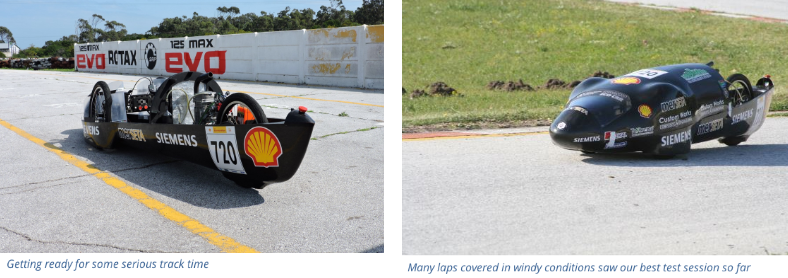
Those 6 weeks were to prove very challenging as a whole host of little issues decided to mess with us, ranging from pressure leaks, to clogged jets, to starting issues, to mapping issues, every single time we arrived at the test track! Things were looking ominous…
However, rather to hit these issues before the event than during it, and the guys responded brilliantly every time we took a body punch and fashioned a solution. But these little hassles were consistent, right up to the day we left…nerve shredding…
We inconceivably broke the spokes on the back wheel late afternoon of the day before we left, and had to fashion re-spoking as late as 4pm in the afternoon - maddening!


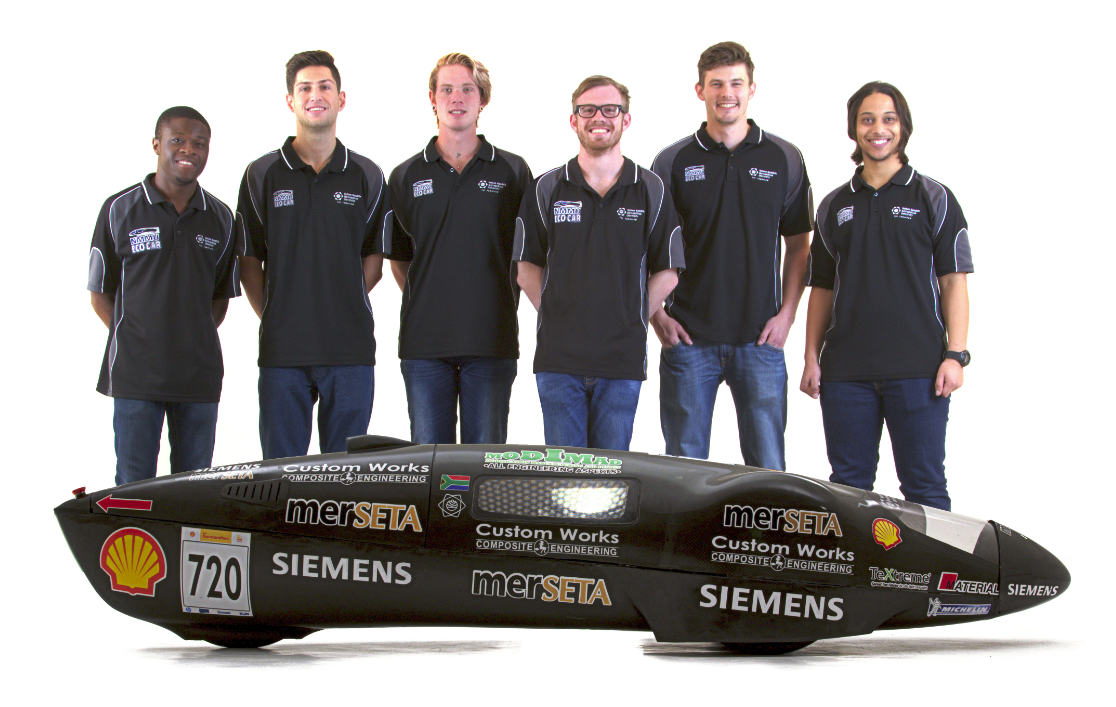
Before we knew it, we were on the road again, 1200 km ahead of us to Pretoria and the 2016 SEM: South Africa. The trip up was uneventful except for insufferable human emissions inside the Blissmobile that certainly did not meet health & safety standards.
Thursday was our free day, and, after spending the early morning logo’ing up the car to her event dress-code, it was Gold Reef City hoy! The promise of rides and multiple servings of ANAT schwarmas had us all giddy with excitement.

We had to be back by late afternoon in order to register & attend the Opening Ceremony, but traffic issues saw us hopelessly delayed in a ridiculous 2½ hours trip back, and arriving quite late while the rest patiently sat it out – red faces all round but we were all forgiven in the end, and treated by the organizers to yet another slap-up meal & met some old friends too…hugely enjoyable!
Some outlandish claims of distances achieved on the stage had everyone real worried, and we went home in some trepidation of what was to come…
Day 1 – Fri Oct 14th - Registration, Scrutineering & Practice
Scrutineering was open early, and we wanted to get in fast so we could maximize our track time later in the day. Thankfully it was plain sailing, and we gratefully received our stickers and started the prep for the afternoon practice runs.
We were first on the line, but that was the case last time around when things went south fast, so there was a lot of nervousness all round. We were flagged off amid some fanfare and our baby lurched forward, then seemed to battle to engage for a few yards – our hearts sank!
All of a sudden she bit, and was haring off into the distance up the pit-lane – relief all round…there was some residue on the clutch but once that had burnt off, it was boiler-plate for the rest of the weekend and we never again encountered a clutch problem.
Waiting for the car come around to complete the first lap was still a very nervous wait…

The afternoon runs went nearly perfectly other than continuous radio problems – there seemed to be a couple of dead spots on the track & definitely a few gremlins in our radio set-up. Some overnight work would see a complete change of strategy in that area.
We were getting good runs in but the track was a conundrum – besides a shifting wind pattern, the Zwartkops track has a seriously long uphill section, so whether you like it or not, you were on the petrol for a good half of the track…the distances were going to be low – all our testing had been on the flat go-kart track where weather was our only nemesis; here, the track’s elevation was to prove a killer for several competitors, and a good few just couldn’t get out of the pits and up the first long hill…
The rest of the afternoon we spent playing around with the strategy to take this into account – we tried everything; slow-speed laps, medium-speed laps, squirt & coast in different areas, it all came back to one thing, you were on the petrol for close to 1.8 kms no matter what or you weren’t going anywhere…
Day 2 – Sat Oct 15th – Practice & Competition
Saturday was scheduled for a morning practice session with the competition starting officially in the afternoon – we elected to stay on our practice tyres for the day and set some benchmark times, and take things from there.
Again, things were going real well – we had sorted out the comm’s issue with an alternative plan that worked brilliantly, and a small connection issue on the e-stop which was a quick fix was the only problem we encountered. We were ready…

The Parade of Nations occurred at lunchtime with TK roped in to proudly lead the parade, and the main competition started shortly thereafter.
The afternoon went very well for us with consistent runs, improving a little bit each time and setting a good base time to get us on the board. After that, it was a matter of trying to improve each time with little tweaks to the driving strategy.
The afternoon ended well with us being top of the Prototype Gasoline category with an official distance of 78.85 km/l. The next day we planned to fit the Michelins and further mess around with the driving strategy to see whether we could push this out even further.
Day 3 – Sun Oct 16th – Competition
Sunday saw us going for broke on our Michelins, but, no sooner than we were out the pits, we suffered a tyre blowout! A freak puncture – this delay set us back a bit, but the next set were great and we put in several runs, steadily improving each time.
Come the afternoon session, we had managed to totally shred one of our sets of Michelins and decided for one more run as the distances seemed to be plateauing out in the wind.
It was an experimental run, trying something that we hadn’t done before…
While the team waited anxiously for the official come-back from the fuel station where Vincent from Shell was labouring over micromillilitres, murmurs from Chris and Mervin made us sit up and take notice – this was going to be possibly our best run yet…
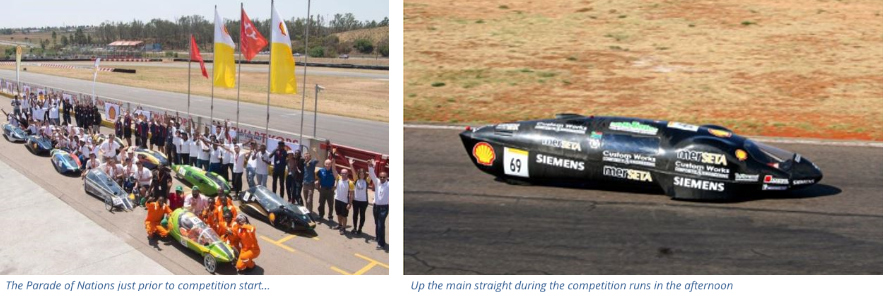
…and it was! A nearly 30% improvement!! The guys predictably went ape-shit…2½ times the distance over our closest rivals – it was quite hard to believe…
That was the end of it – the wind was up and the game was over, all we could do now was wait and see whether the other competitors in our category could come close.
At 15:00, the track closed and we were the SEM: South African Champions in our category - what a brilliant effort from our guys; no team has worked harder and deserved it more; we were massively proud of them.
So, at the end of it, it was the Prize Giving, photos all round with all the other teams, and enjoying a few frosty ones with the guys from Shell and UJ, the organizers, and then saying our goodbyes and packing up and leaving for our last night in town.
Monday was the long haul back to Port Elizabeth…

Back to Reality
Coming back home was somewhat surreal – the University was closed completely because of the countrywide student protest action, and things were to stay that way for the rest of the year, as emergency measures were rolled out to ensure everyone could do their exams off-campus and complete the academic year.
Sure there was interest from the local media, but it was odd not to be back on campus and also there was no real time to wallow(!) in the glory of our achievement! It was almost like Port Elizabeth just simply didn't recognize our existence :)...

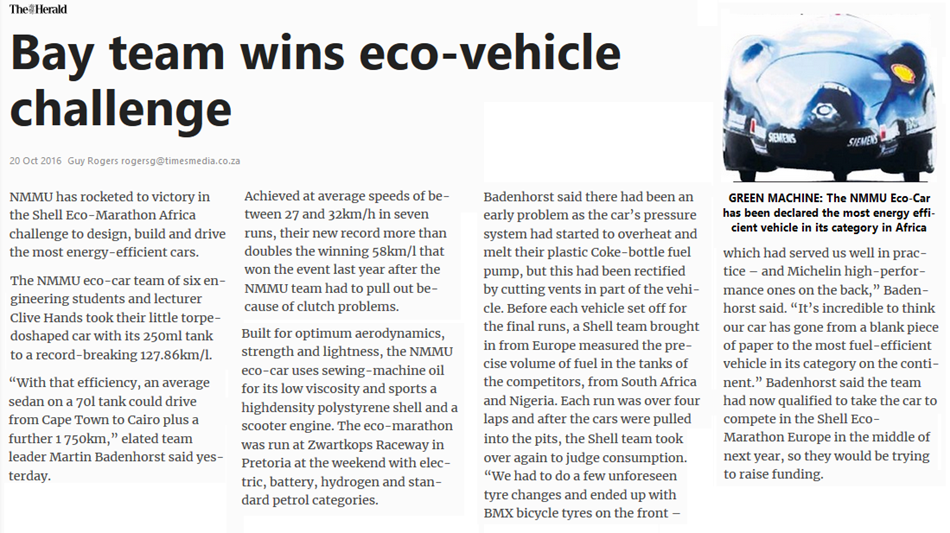
A New Year and New Goals and New Faces
Due to exams being extended well into December, everyone took a short but well- earned break over the Xmas and New Year period, and we were back in towards the end of January to start the whole process over again for 2017.
The development of our carbon-fibre wheels, which had been delayed by the shutdown action, took on a new focus and they were complete and on the car by end of Jan – Martin had done a brilliant job in their design and optimization, and they looked grand, especially on the car.
We also had to welcome several visitors through the Eco-Car Lab as interest belatedly picked up, and we were hugely pleased to welcome Altair on board as formal sponsors for the year ahead.
Brett was promoted to Team Leader, with Martin taking on purely an advisory role due to his new commitments, and our new program of development eased into motion – it was shaping up to be another very busy year for all…
We also welcomed brand new team members in Nureen Hoosein and Kahl Kritzinger – both final year Mechatronics students & finally a driver under the 50 [kg] barrier that has proved so challenging to us so far.
A brand new programme was put in place & there was much work to be done!

Sadly, times of change also meant we had to say goodbye to some of our long-serving alumni, and Charlie moved on to other responsibilities (although still in our offices), and TK took up an option to further his studies in Beijing, China as part of a merSETA initiative. Great howls, crocodile tears & gnashing of teeth saw us reluctantly wish them well in their future endeavours…
A huge bit of good news was that Altair had by now officially came on board as a sponsor of the Eco-Car Team following our very positive involvement with them over the last year and a bit; so things were really looking up on the light-weighting and optimization side of things, and their suite of world-class software tools was going to play a huge part in that.
Martin’s research around the design, optimization & manufacture of an ultra-lightweight carbon composite wheel was a direct output of our involvement there, and his impressive work was rewarded with an invite to present at the prestigious 2017 Altair ATC: Europe Conference to be held in Germany in June…genuinely superb stuff!
Once again, our plans were to compete in 2017 SEM: Europe in London, and we went through the Phase 1 and Phase 2 registration procedures without too much difficulty – the hopes of a nice sponsorship and some stability in our currency, especially in light of an unstable global environment, would pretty much dictate which way that went. However, we remained optimistic… meanwhile, it was time to knuckle-down!
We were also fortunate enough to be able to present as guest speakers at the Altair ATCx: Gauteng Conference in March, which was hugely rewarding and opened up a whole range of outlets for ideas that we had been kicking around for a while.
The next major event for the team, other than keeping things ticking over and ensuring that our light-weighting and upgrade programme was on track, was the annual Knysna Motor Show at the end of April – this year it was bigger and better than ever despite the stifling heat! Hugely enjoyable stuff…
This would however prove poignant in a month or two, as many of the exhibitors and members of the Garden Route Motor Club who organise the show, would suffer heart-breaking loss in the terrible fires that wreaked havoc in the town…
SEM: Europe would again prove to be beyond our financial reach, and we had to call it yet again, and re-focus on the immediate future. Someday, maybe…
With approaching exams and the mid-year looming, we were sadly to say goodbye to yet two more stalwarts of the team from the last year-and-a-bit as both Chris and JR moved on with their lives – this necessitated a bit of a team overhaul, but we welcomed new members Chris Abraham and Matthew Henry on-board for the run-in to the 2017 SEM: Africa; new blood, some new ideas and an enthusiastic fresh blast of air through the team saw everyone reinvigorated and recharged.
A huge event for the team was Martin’s involvement in the Altair ATC: Europe Technology Conference in Frankenthal, Germany at the end of June, where he presented on the design and optimization of the Eco-Car’s ultra-light-weight composite wheels – this was in the company of some of the engineering world’s big hitters and was a massive achievement and privilege.
Once mid-year exams were done and dusted, a few weeks of space opened up and the new team got down to some serious work, starting off with a working jaunt down to Jeffreys Bay to get an additional composite wheel made with our long-term supporters CustomWorks, in preparation for some on-track testing in late July to see how the new updates worked out.
We were down to 100 days all of a sudden, and they had to be used well.
August and September blew by in a flash, and before we knew it, we were in October and the 2017 Shell Eco-Marathon: South Africa was just weeks away!
The guys had been working hard behind the scenes though, and much new work had been successfully completed in various sectors in improving the car and its on-board and off-board systems.
Much lightweighting had been achieved, the efficiency of the engine was a huge improvement, all electrical systems had been optimized, and bespoke telemetry and comms systems were now cloud- and web-based, which had opened up an entirely new area of focus for the team and its associated projects – so a lot had been happening behind the scenes, and the guys had achieved miracles…
The three weeks leading up to the event were going to be about as much testing as possible, which allowed the odd scaring of cars & students on the back-roads of the South Campus as well! Hugely enjoyable!!

